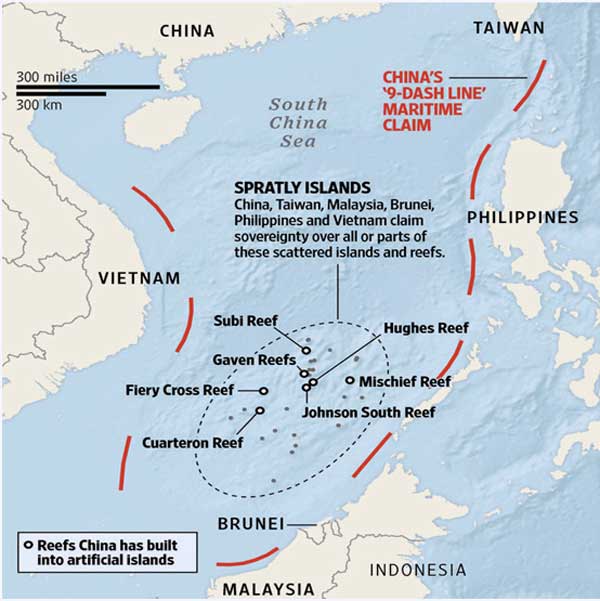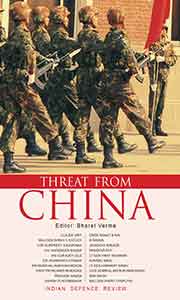
The map above indicates the area where China is reclaiming the reefs to build infrastructure for runways and berthing sites. A major airfield is being constructed on Fiery Cross Reef which would facilitate operation of Cargo, Surveillance, Fighters and Bomber aircraft.
Since 2000, the US Department of Defence has been publishing an annual report on military and security developments involving China to gauge its military preparedness, particularly, against Taiwan. However, if the 2016 report is to be believed, Taiwan is no more the focus for Chinese military preparedness. Instead, South China Sea is fast emerging as the new battle zone to test Chinese military preparedness against local adversaries and the US. Recent developments attest to Pentagon’s hypothesis.
Till much of the last decade and half, Taiwan remained the numero-uno flash point in the Asian security complex. The Taiwan Government was at loggerheads with China. The mutual hostility even led to some crisis situations. The US, committed to protect Taiwan under the ‘Taiwan Relations Act’ (1979), started publishing the annual report pursuant to the National Defence Authorization Act (2000).
A major objective was to assess Chinese capabilities to wage and win a limited war against Taiwan and to enlighten the US response. The annual reports concluded that Chinese offensive capabilities were weak and did not guarantee a clear victory in a limited war offensive against Taiwan. In fact, Chinese dream of capturing Taiwan was often pooh-poohed as a ‘million-man swim’ across the Taiwan Straits.
However, the scenario has changed today. In the last fifteen years, China has changed the military balance of power across the Taiwan Straits and has made any comparison simply unwarranted. Chinese military modernization, visible in the deployment of missiles, fighters and ships on the shores of Taiwan Straits, has diluted the Taiwanese dream for ‘One China, One Taiwan’ and weakened the pro-independence forces in Taiwanese politics. Concurrently, China has encouraged larger integration of Taiwanese economy with mainland and has facilitated largest inflow of Taiwanese FDI into its economy.
China has also emerged as the largest trading partner for Taiwan, thereby, increasing the military misadventure cost for Taiwan. Most importantly, China has opened up non-state contacts between two sides under the auspices of Association for Relations across the Taiwan Straits (ARATS).
The cobweb of relations has ensured that Taiwanese people, including political parties, give up expectations of any Taiwanese independence, and work on improving relations with mainland. This is indeed the focus of all political campaigns in the island territory. China is satisfied with status quo since Taiwan is not advocating a separate identity for itself in international relations. In November 2015, President Xi Jinping of China met with the then President Ma Ying-Jeou, the first such meeting since 1946, and reiterated the importance of maintaining the status quo. War is ruled out as short term or long term solution to China’s desire for ‘One China, two systems’ theory or opposition to it. Taiwan is, thus, no more ‘the flash point’ and the Pentagon report discreetly says so!
If not Taiwan, what is that hot spot that drives Chinese military modernization and force build-up? Visibly, it is South China Sea. As Pentagon reports, ‘China’s actions in the South China Sea in 2015, particularly its land reclamation on features in the Spratly Islands, enhanced the appearance of China’s ability to exercise control over disputed areas, raised tensions in the South China Sea, and caused concern over China’s long-term intentions’. The report elaborates China’s land reclamation (about 3200 acres) along with addition and expansion of Chinese outposts in the disputed areas and concludes that China is bolstering its de facto control by improving its military and civilian infrastructure in the South China Sea. The airfields, berthing areas, and resupply facilities will allow China to maintain a more flexible and persistent coast guard and military presence in the area.
Chinese activities in the South China Sea, therefore, has led to greater confrontation between China and other claimants for the disputed territory, and most notably, to increased Sino – US tensions. The US, determined to thwart Chinese domination of the area has been sending patrol ships in the disputed waters claiming navigational rights under international laws. China’s increased oceanic and overseas access, facilitated by increased naval vessels and aircraft career, has led to an ‘insecurity dilemma’ amongst the other claimant countries about Chinese strategic intentions. Unless China is encouraged into more cobwebs of cooperative security ventures, its coercive tactics would perpetuate tensions in the South China Sea and could seriously jeopardize regional peace.
What about Chinese military build-up along the India border? Unlike the front-page reports published in some newspapers wherein the Pentagon report was quoted as China having amassed huge military build-up in Tibet area, it ‘actually’ does not say much! India is simply mentioned as one of the focus areas for China. ‘Tensions remain with India along their shared 4057 border…despite increases in China-India political and economic relations’, is the only important statement in the report.
The Pentagon report is focused on US security interests in the Asia-Pacific region and does not cater to India’s threat perceptions. Therefore, there is a need to assess Chinese threat perceptions from an Indian perspective else risk the peril of ignoring another hot spot in Chinese military-build up and even the possibility of another Sino – Indian war.





